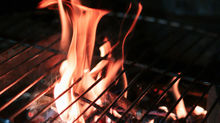Digging into the history of the 4th of July Food Part One
- Jun 28, 2020
- 3 min read
This is a two-part series on the culinary history of the 4th of July.

Fireworks at Land O Lakes WI circa 2017
One of the most memorable moments of my food writing career was when my Australian Sister-in-law sent me an article she had cut out of the Courier-Mail newspaper in Australia. It was the same article I had written for my local paper with my byline that had been put out on the wire service and had been picked up by them. They swapped out the picture of Baked Indian Pudding for a giant hamburger, and changed the name to "Star-Spangled Dinner" I had mixed feelings, but they could change it to fit the needs of their readers.
I had worked on this article for a local newspaper at the time and didn't realize the reach of my words. So, many years later, the story is worth repeating to remind us of our roots as Americans. This is part one of a two-part series of how the traditions started and some of the historical recipes that have survived the ages.
John Adams proclaimed a day of celebration
When John Adams signed the Declaration of Independence, he wrote to his wife, Abigail, that the day of the signing "Will be the most memorable epoch in the history of America.
"...I am apt to believe that it will be celebrated by succeeding generations as the great anniversary festival. It ought to be commemorated, as the day of deliverance by solemn acts of devotion to God Almighty. It ought to be solemnized with pomp and parade with shows, games, sports, guns, bells, bonfires and illuminations from one end of this continent to the other; from this time forward, forevermore."

Curiosity about food traditions from the original Fourth of July led us to Lynne Farrington, Curator of books at the Annenberg Rare Book and manuscript Library at the University of Pennsylvania in Philadelphia. The Annenberg library has a tremendous collection of rare books on all things culinary.
Farrington shared the information this article from several historical treatises and sources including "Celebrating the Fourth Independence Day and the Rites of Nationalism in the Early Republic" by Len Travers; "The Glorious Fourth: An American Holiday, An American History" by Diana Karter Appelbaum: and "The American Heritage Cookbook and Illustrated History of American Eating and Drinking"
The Adamses Celebrations
Though the Adamses celebrated the Fourth of July each year with enthusiasm, their tastes at the dinner table reflected the New England thrift and simplicity. On the menu at their home:
Turtle soup, Broiled Salmon Steaks or New England Poached Salmon with Egg Sauce,
Green Peas, Boiled New Potatoes in Jackets, Indian Pudding, or Apple Pandowdy, coffee, and tea.
As celebrations across the country grew and got more elaborate, there usually was a "committee of arrangements" that had the privilege of drawing up the Fourth of July program. Readings of the Declaration of Independence were very popular.
Toasts were de rigueur, often punctuated with musket or cannon fire and followed by a patriotic or political song such as Adams and Liberty or new lyrics were written for "Yankee Doodle"
It didn't take long before the crowds of those who wanted to observe formal ceremonies outgrew a single church or tavern. Each celebration had its own orator, followed by multiple dinners, It has been postulated that this is how America's first political parties were formed. And it was at these first ceremonies that the myriad of Fourth of July food traditions started.

Picture from Getty Images
Next Post will feature more culinary history antidotes about celebrations and recipes, stay tuned.











































Comments